 Washington Trails
Association
Washington Trails
Association
Trails for everyone, forever
Two WTA staffers break down their methods for planning what goes in their packs — and for ensuring they have the experience they want on their backpacking trips.
Loren Drummond is WTA’s digital content manager. When she hits the trail, she’s looking to unplug and chill. As long as she’s out of cell range with a sky full of stars over her head, she’s satisfied. She’s happy to give up civilization for a day or for seven, but don’t expect her to leave behind the joys of delicious meals, hot drinks and a great novel.
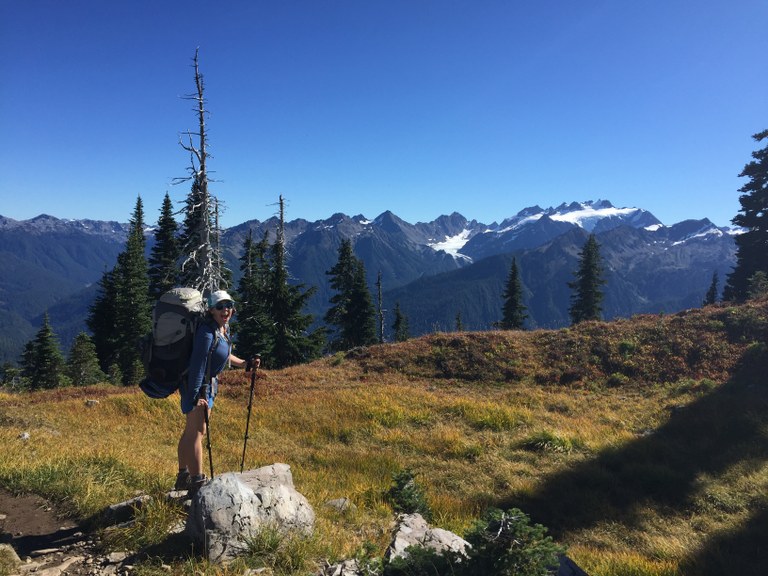
Loren Drummond took a novel and hammock for a trip in Olympic National Park. Photo by Tyler LePard.
When I go backpacking, it almost doesn’t matter where I am: an alpine basin, a canyon floor, on the edge of a meadow. As long as it’s someplace wild and quiet, I’m good. If they gave out an award for least-ambitious backpacker, I’d have a solid shot at winning it. Not because I can’t hoof it 15 or 20 miles in a day; I’ve done that. But most of the time I’m just looking for a little bit of mountain or desert time with my family and friends.
I’ve done 3-mile overnights — on purpose. When we hiked north from Hart’s Pass on the PCT a few years ago, our first camp was 2 miles in. It had epic views. The next night, we planned to go much farther, but we found a camp 4 miles along that we liked so much, we stayed 2 nights. We set up a hammock, feasted on the camp’s huckleberry patch and explored the area. In 4 days and 3 nights, we covered a whopping 12 miles (if you don’t count our day hikes).
When I plan trips, I really want the experience to be fun and comfortable for everyone. The must-do miles on my itineraries tend to be short, with plenty of options for explorations — but only if the mood strikes. Suffering is never on the agenda. Naps, elaborate breakfasts, swimming and reading are.
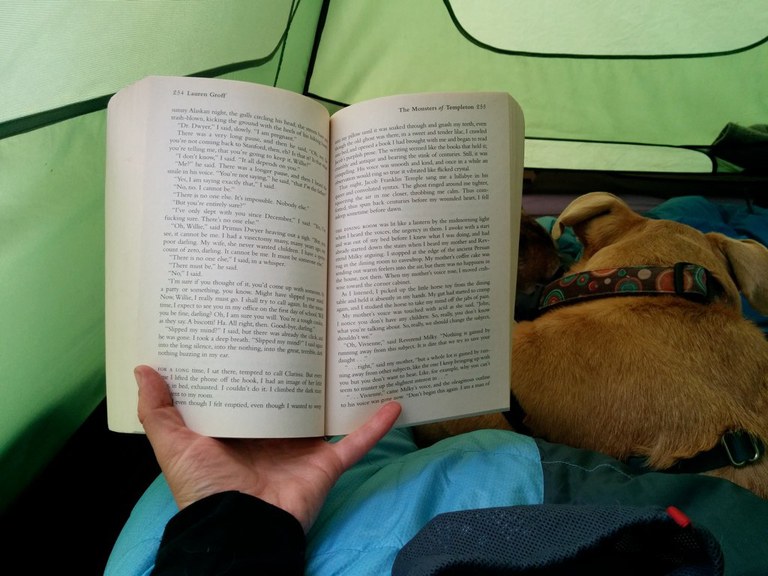
Reading during a rainstorm. Photo by Loren Drummond.
That means that while I don’t carry a heavy pack — I try to keep it around 30, but it’s hit 40 for some trips — I’ll always opt for a few comforts that aren’t strictly necessary. Hammocks, bug nets, camp chairs, novels, games. When we hike with friends, I’ll usually toss in an extra layer and a few extra ounces of fuel just in case someone gets cold or wet. I even tracked down a used (and light) three-person Big Agnes tent to size up from our two-person. When you spend a few hours waiting out the weather by reading, it turns out that carrying a few extra ounces for extra headroom is worth it.
I take the same approach even when I’m pulling more miles and carrying trail tools. I hauled in fresh avocado and a (gasp) hardback sci-fi novel on my last backcountry response team trip in the Salmo-Priest Wilderness. After four soggy evenings with lots of tent time, I was the only one who hadn’t exhausted my reading material. It was a little ridiculous, but I’d rather hike slowly than go stir-crazy.
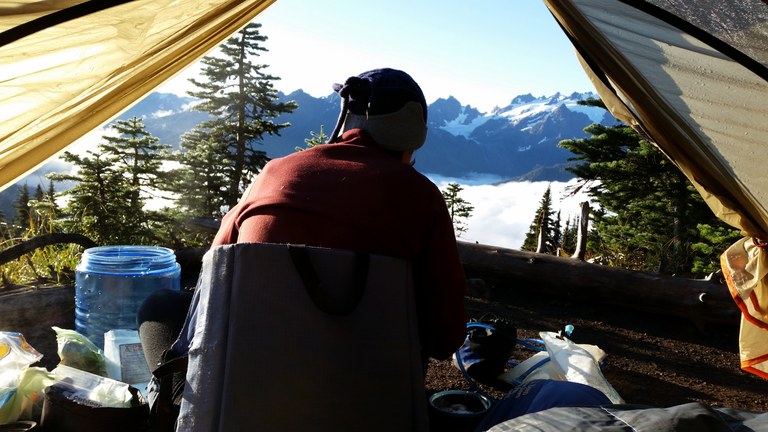
Making coffee on the porch in Olympic National Park. Photo by Tyler LePard.
I do have burlier, longer trips on my to-do list — solo trips and monthlong trips — and when I tackle those, I’ll go begging my ultralight colleagues for their packing lists. But in the meantime, I like how easy it is to just get out for a night or two without much advance planning. Lower miles tend to lower the stakes and the stress of getting out of town. I don’t agonize over every item we pack, and if we get a late start — well, no big deal.
All I really want is to wake up someplace beautiful and savor a cup of coffee while I watch the stars fade and the sun rise. And if I end up carrying a few extra pounds, it can only make me stronger.
Andrea Imler is WTA’s advocacy director. She works hard and she plays hard. For her job, she advocates for our wild places. And she loves to get out to see those wild places firsthand. Sometimes, that means covering big miles. To make those big miles possible — and fun — she also likes to keep her pack light.
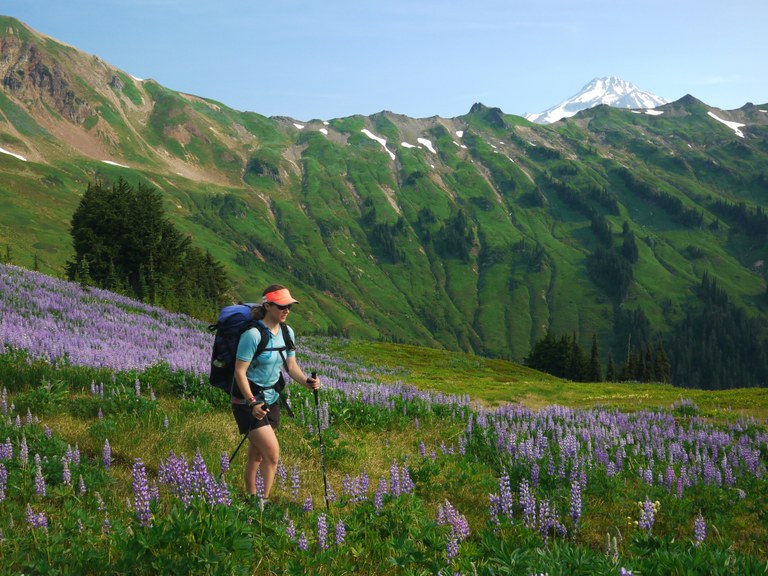
Andrea Imler went light for a beautiful trip in the Glacier Peak Wilderness. Photo by Todd Schneider
Backpacking brings me such joy. With my pack on my back, I can wander deep into the beautiful areas across our state. I can spend days exploring meadows, forests and mountain lakes.
Every August, I like to take a long trip. I enjoy planning long hikes, especially loops. Last summer, I did a circumnavigation of Glacier Peak. That trip was an adventure, and it took me to beautiful places. Because my pack was light, the trip was fun and the miles weren’t too hard on my body. For a 9-day trip, my pack usually starts out at about 33 pounds, including about 20 pounds of food and water. As I eat food, the pack gets lighter quickly.
My pack wasn’t always this light. When I started out more than 16 years ago, I bought what I could afford. But as I kept backpacking, I wanted to lighten my load, so I focused on reducing the weight of the heaviest things first, like my tent and sleeping bag. I made them my priority, saved up and bought lighter gear when I could.
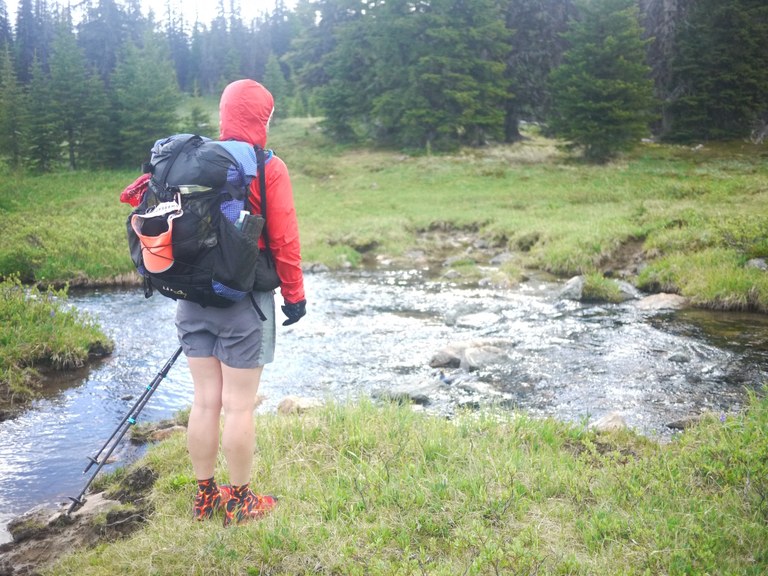
Andrea scouts a stream crossing during a trip in the Pasayten. Photo by Todd Schneider.
I’ve also cut down on what I carry. I used to pack two warm hats and two pairs of gloves — not sure why. Now I carry one of each. A tiny deck of cards and a camera are my luxury items, although I’m considering ditching the camera to use my phone instead. I don’t need more than that.
Every year, before my annual long trip, I take a number of shorter trips. Those are my shake-down trips, where I test out new approaches to what I pack. A while back, I bought a quilt to replace my sleeping bag. It was light but I learned pretty quickly it just didn’t keep me warm enough. So I sold it and bought a used bag — it’s 10 ounces heavier, but I’m cozy at night.
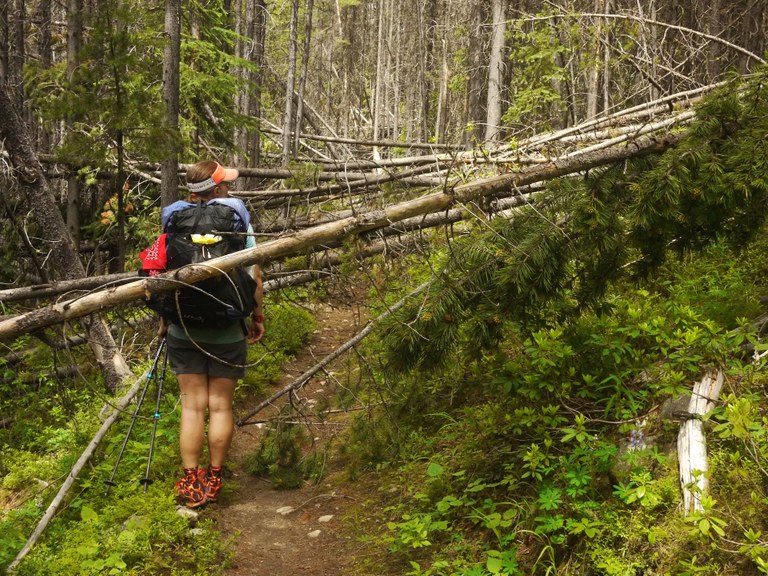
Keeping my pack light takes planning — but that’s part of the fun. I like the nerdy details. Before my biggest trips, I leave the previous weekend free so I have time to carefully prep food and gear. I even bought a kitchen scale to weigh my gear, which helped me see where I could cut unnecessary weight. Do I really need to bring a half pound of extra clothing? No! I also check the weather reports carefully, using at least three sources, so I can be as confident as possible about how many layers I need to be comfortable.
There’s nothing particularly special about my method. Sure, I’ve figured out my system over many trips. But anyone can do the same. There are great resources online, and if money’s an issue, look for used gear and replace items slowly.
The joy you’ll get from the time outside with less weight on your back will make it worth it; it certainly does for me.